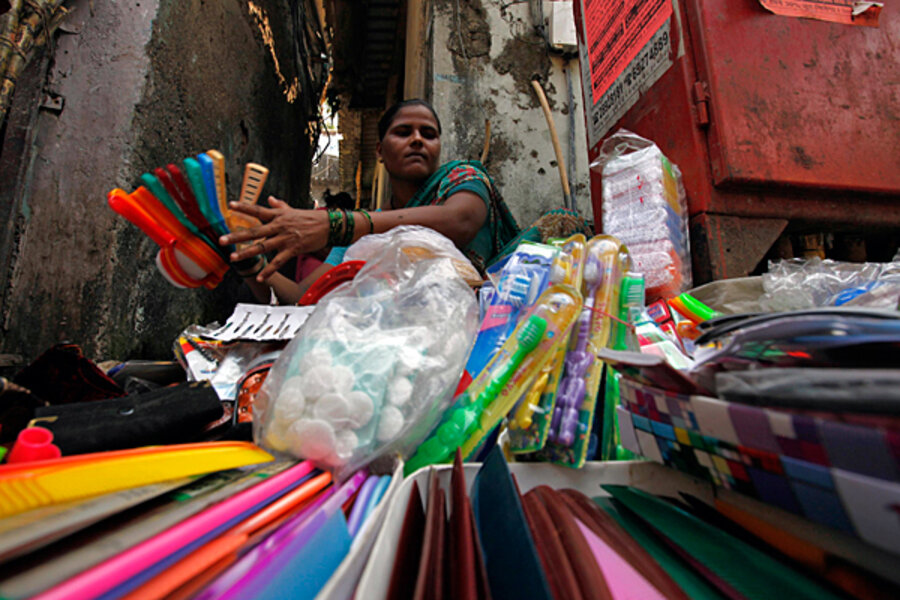India's $5 billion microfinance industry faces backlash over profits
Loading...
| New Delhi
Microfinance, hailed as a silver bullet to uplift the poor, has grown into a $5 billion industry in India. But a political backlash against strong-arm lending by profit-driven companies has left some lenders struggling to stay afloat, raising questions about the industry’s rapid expansion and the dilution of its social mission.
Industry associations warn of a liquidity crisis comparable to the US credit crunch in 2008 as banks cut off credit lines to microfinance institutions (MFI) that depend on outside funding. An industry lobby group said Tuesday that lenders were seeking $221 million in emergency loans, according to Bloomberg News.
Other lenders are less exposed. Some collect deposits and make loans within poor communities – a model known as "self-help" groups – though these groups also borrow from banks to increase their pool of capital. Mohammad Yunus, founder of Grameen Bank and Nobel Peace Prize laureate, pioneered this model in Bangladesh.
But the current crisis is roiling the entire industry, says Matthew Titus, executive director of Sa-Dhan, a Delhi-based association that groups over 260 nonprofit, self-help, and commercial lenders. “It’s not only the bad boys that will get hit. Everyone will get hit. People can’t differentiate between who are the good boys and who are the bad boys,” he says.
Has the industry lost its roots?
The backlash began last month in the southern state of Andhra Pradesh, where indebted farmers were reportedly hassled by lenders to repay loans with interest rates of 30 percent or more. Local politicians have linked these practices to a spike in rural suicides, though observers say the link is unproven. State regulators have ordered a freeze on loan repayments where the interest exceeds the principal, which cuts off liquidity for struggling MFIs.
While India has a vast pool of rural and urban poor, many MFIs work in southern states that boast higher literacy rates among women – the usual target group – and greater economic dynamism. Andhra Pradesh accounts for 28 percent of Indian microfinance loans, double the size of the next largest state. This regional concentration has allegedly exacerbated the sharp competition among lenders and led borrowers to take on multiple loans without proper oversight.
Critics say the surge in for-profit MFIs driven by equity investors has skewered the industry away from its pro-poor roots. M S Sriram, an independent scholar on microfinance in Bangalore, says there is an inherent contradiction between “people-oriented” schemes and MFIs that focus on quick returns. “The client is secondary. Therefore the tensions get heightened,” he says via e-mail.
Microfinance's lightning rod
India’s largest lender is Hyderabad-based SKS Microfinance, which raised $350 million in equity in August and has become a lightning rod for critics. Speaking Tuesday at the World Economic Forum in Delhi, its chairman, Vikram Akula, defended SKS and blamed “rogue” lenders for the backlash. “Do not destroy the entire industry because of the actions of a few rogue players,” he said.
Since the crisis began last month, SKS has voluntarily lowered its interest rate, currently around 24 percent. Commercial MFIs say they must cover the cost of making thousands of tiny loans, usually $200 or so, without accepting deposits, as banks do. Mr. Akula said its scale of operations allowed major lenders like SKS to charge progressively less for loans compared to Latin America.
Not everyone is convinced by this argument. Mr. Titus says that commercial lenders cut costs by poaching loan officers from their rivals and targeting the same borrowers. This allows them to collect a higher return on equity as they don’t have to invest in new communities, which normally require training and preparation in how to use microfinance.
Justin Oliver, executive director of the Center for Micro Finance at IITM University in Chennai, says the overlap in lending by competing lenders isn’t necessarily a problem. In a new report, the center found that 60 million Indians belong to financial self-help groups, while 26.7 million had loans from MFIs. It estimated that 16.3 million had borrowed from more than one source.
“It makes sense for people to want to be part of multiple groups at the same time to keep lines of credit open for when they need it in the future,” he says.
Backlash takes a political dimension
The backlash against MFIs in Andhra Pradesh has a political dimension. Many of the existing self-help groups are backed by public banks, which are in turn overseen by local politicians who use their largesse to build vote banks. By undercutting these lenders, commercial MFIs are threatening this patronage network.
Analysts point out that regulators appear focused solely on curbing commercial lenders, rather than tackling systematic risk. A ban on loan officers collecting weekly repayments, the normal practice in microfinance, is a major blow to these lenders.
This isn’t the first time that microfinance has run into trouble in Andhra Pradesh. In 2006, several suicides in one district led to the temporary closure of MFIs accused of coercive practices. The neighboring state of Karnataka also suffered a wave of defaults last year after local Muslim leaders objected to usury on loans, which Islam forbids.





